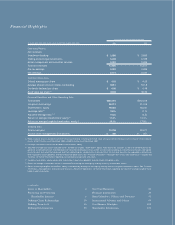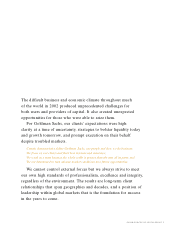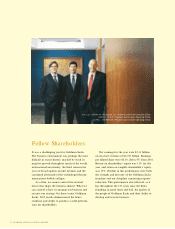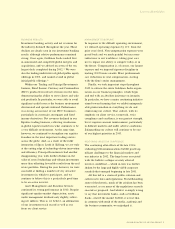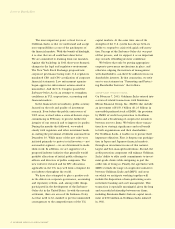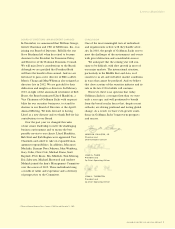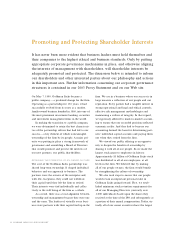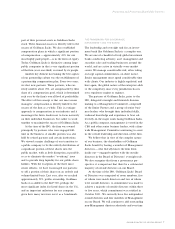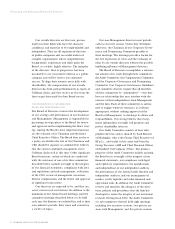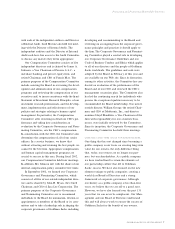Goldman Sachs 2002 Annual Report Download - page 9
Download and view the complete annual report
Please find page 9 of the 2002 Goldman Sachs annual report below. You can navigate through the pages in the report by either clicking on the pages listed below, or by using the keyword search tool below to find specific information within the annual report.
GO LDMAN SA CH S 2002 A N N UA L R EPO RT 7
part of their personal assets in Goldman Sachs
stock. Their financial success is directly tied to the
success of Goldman Sachs. We also established
compensation plans in which a significant portion
of compensation —approximately 45% for our
most highly paid people—is in the form of equity.
Today, Goldman Sachs is distinctive among large
public companies in that a very significant portion
of the firm (over one-third) is owned by its people.
Another key element in retaining the best aspects
of our partnership culture was the establishment of
a partnership compensation plan. Every two years,
we elect new partners. Those partners, who cur-
rently number about 290, are compensated by their
share of a compensation pool, which is determined
each year by the firm’s overall level of profitability.
The effect of this concept is that our most senior
managers’ compensation is directly linked to the
success of the firm as a whole. This is a unique
approach to compensation in our industry and it
encourages the firm’s leaders not to focus narrowly
on their individual businesses, but rather to work
together to maximize the success of Goldman Sachs.
At the time of the IPO, the firm was owned
principally by partners who were engaged full-
time in the business. A smaller portion was also
held by retired partners and certain institutions.
We viewed a major challenge of our transition to
a public company to be the orderly distribution of
a significant portion of these shares into the
public market, with as little disruption as possible,
so as to eliminate the market “overhang” issue
and to provide deep liquidity for our public share-
holders. With the exception of the three most
senior officers, we have encouraged our partners
to sell a portion of their shares on an orderly and
volume-limited basis. Last year, after we reached
approximately 50% public ownership, Goldman
Sachs was added to the S& P 500, perhaps the
most significant index for listed shares in the U.S.,
and an important milestone for any company,
given how many investors use it as a benchmark.
THE FRAMEWORK FOR GOVERNANCE:
MANAGEMENT AND THE BOARD
The leadership and oversight task for an invest-
ment bank like Goldman Sachs is a complex one.
We are one of a handful of truly global investment
banks conducting advisory, asset management and
securities sales and trading businesses around the
world, and are active in virtually every market
center. We manage considerable risk, often taking
on large capital commitments, on short notice.
Senior management must spend considerable time
with clients. Our industry is highly regulated, and
here again, the global nature of the enterprise adds
to the complexity since every jurisdiction has its
own regulatory regime or regimes.
The partners of Goldman Sachs, prior to the
IPO, delegated oversight and firmwide decision
making to a Management Committee, comprised
of the Senior Partner and a group of senior busi-
ness leaders who brought their individual skills,
technical knowledge and experience to bear col-
lectively on the major issues facing Goldman Sachs.
As a public company, management is vested in the
CEO and other senior business leaders, with a firm-
wide Management Committee continuing to assist
in the overall leadership and direction of the firm.
We believe that in view of the complex nature
of our business, the shareholders of Goldman
Sachs benefit by having a number of Management
directors—who literally know the firm from
inside out —engaged together with the outside
directors in the Board of Directors’ oversight role.
We also recognize that from a governance per-
spective, it is important that there be a substantial
majority of outside directors on our Board.
At the time of the IPO, Goldman Sachs’ Board
of Directors was comprised of seven members, five
of whom were inside directors and two of whom
were outside directors. A commitment was made to
achieve a majority of outside directors within three
to five years, which commitment was satisfied in
October 2001. We currently have five independent
outside directors and four members of Management
on our Board. We will continue to add outstanding
non-Management directors selectively and over time.
Prom oting and Protecting Shareholder Interests


